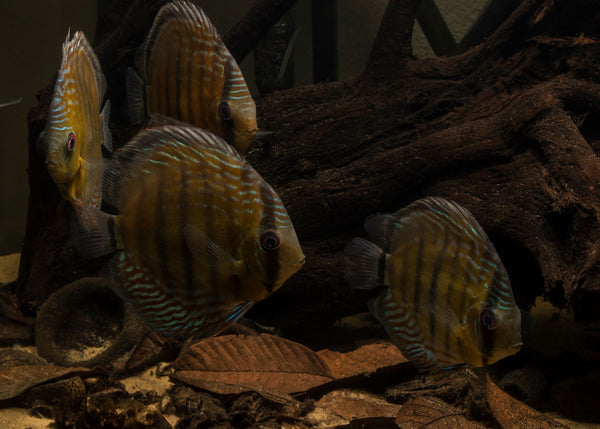- Continue Shopping
- Your Cart is Empty
Expectations...a "refresher course."
With more and more hobbyists trying out aquatic botanicals and emerging themselves in the world of blackwater aquariums, it seems like a good time to once again sort of visit some of the "basics" of our "practice" here.

There are many questions we receive from newer "tinters" after they decide to take the plunge and join our dark, murky world, and, although we've talked about most of the considerations, techniques, and expectations in some 500- plus blogs since we got started here, it makes sense now and then to review some of this stuff! Today, let's talk about one of the aspects of the "mental shift" that is an important part of being successful with blackwater/botanical-style aquariums: expectations.
Yes, expectations.
You see all of the cool pics of amazing natural habitats. You read the excited comments on Facebook and in forums from blackwater enthusiasts as they start and evolve their aquariums. You see the "unboxing videos" and "how to's" on social media (Thanks, guys- keep 'em coming!). And you're ready to pull the trigger and jump in for yourself! It's a very exciting time!
Visions of exotic, tannin-stained Amazonian blackwater tributaries and ridiculously colorful characins, spawning Apistogramma pairs, and stately Angels and Discus cruising in an exotic, richly-tinted, leaf-filled world fill your mind...
However, like all things we aspire to or envision in the hobby, the ultimate goal of a blackwater paradise requires us to understand things and take some steps, perform some tasks, and endure a few challenges in order to get there! One of the first things we need to realize is that all of these cool botanicals, while they do impart tannins, humic substances, and other organics into the water, cannot perform "spontaneous miracles", transforming your blue-white tapwater into a Brazilian igarape overnight!

First off, you need to take the time to properly prepare the botanicals for use in your aquarium. This almost always means you're going to be boiling and/or soaking them before they ever hit your tank.
Sure, there are some items, such as leaves, which require (depending upon who you talk to) less in the way of preparation, but everything you add needs some prep. On our website, we've put a lot of effort into providing you with preparation instructions for every botanical we offer. And, as we (that's us here at Tannin, and you- our community!) use them more and more, we edit these recommendations, too! Please take a few minutes to read this information, as it will get you off to a good start! Caution is always advised- you're adding all sorts of items into a closed biological system. There will be impacts. There could be risks associated with doing so. We won't sugar coat it.
Now, once items are added to your aquariums (slowly, we always say...never all at once), you will see a gradual coloring up of the water- the degree to which your water will color up depends upon multiple factors, including which botanicals you're using, how many of them, how long you steeped or boiled the botanicals, and wether or not you're utilizing any filter media (such as carbon) which will remove the tannins from the water. This process doesnt happen overnight. It takes a little while. While we admonish you to be patient as your water "tints", if it makes you feel better, scoop a little out and pour it into a white bowl, and compare it to your tap water. After just a few days, you're likely to see a significant difference in color!
Now, a lot of hobbyists speculate on how much the pH of their aquarium water will change as a result of adding these botanicals. This is another aspect of botanical aquariums that has no "set answer", because there are numerous factors that can affect this, not the least of which is the alkalinity and hardness of your water before you start adding these materials. We frequently receive questions from hobbyists who are surprised that the botanicals they've added have not dropped their pH from 7.8 to 6.6 or something. "Why is it only 7.4?", we'll hear them ask. And again, our answer is, "It depends."

If you have very hard, alkaline water, and a buffering substrate material, even a significant influx of botanicals can only influence the pH by so much. Our recommendation, based on years of playing with blackwater aquariums, is to start with water with very low to non-existent carbonate hardness- reverse osmosis/deionzed water (RO/DI) is the way to go, and an investment in a quality RO/DI unit will pay dividends for years, for both "tinted" and "standard" aquariums!
And of course, once you've had your botanicals underwater for a few weeks, what happens then? Well, like anything exposed to water, they start to break down. This is part of the natural process and the "charm", if you will, of the botanical. blackwater aquarium. You need to look at botanicals, particularly leaves, as "transient" materials, ultimately requiring replacement after they decompose in your tank. You can either remove them, or simply add more materials.

It all depends upon your "tolerance" for the aesthetics of decomposing materials in the tank. I personally, having made that "mental shift" a long time ago, embrace this process and it's aesthetic as the ultimate expression of Amano's "wabi-sabi" philosophy. The beauty of nature and the visual aesthetic of materials evolving in your aquarium is a remarkable sight, in my opinion.

This is what happens in nature, and it's perfectly normal for it to happen in the aquarium. We need to sort of "train ourselves" to understand that this is how things really are in nature, and if we choose to fully embrace the process and aesthetic, that this is the essence of the botanical-style, blackwater aquarium experience. It's not a perfectly-manicured, aesthetically-precise "garden."
Rather, it's a naturally-appearing, naturally-functioning ecosystem. It requires understanding, monitoring, patience, effort, and caution.

And then, there are those biofilms!

Yes, biofilms are at the lower end of the "food chain"(literally!) in the botanical aquarium- as in nature- and perform a vital role in facilitating environmental stability and continuity. While they are absolutely NOT the most attractive thing we see in our tanks, they are not cause for panic, or for ditching the whole experiment! Typically, they start out as a "phase"-usually early on in the life cycle of your botanical-style blackwater aquarium. It's absolutely natural- they by product of a significant quantity of organic materials in your tank. Fungi and bacteria act upon the botanicals to break them down and process the abundant nutrients they release into the water. Other creatures, ranging from micro-crustaceans, to insects, and even fishes, consume these biofilms.

While disgusting in appearance, they are among nature's most useful and necessary organisms. They're present in every body of water, including your visually pristine "nature aquarium"- it's just that, in the context of a botanical-fileld blackwater aquarium, they're front and center! Just like in nature. Sure, the initial sight of them in your tank is both startling and often times, upsetting for those who've never experienced them before. They generally are more significant and last longer during the early phases of your aquarium, as it establishes itself and matures biologically. While they may or may not ever completely disappear from your aquarium-or they may "ebb and flow" over time- they are to be "embraced", and not reviled. It's hard. It's contrary to what you know.
It's a mental shift that you need to make if you are to try embrace the unique and aesthetically/functionally different blackwater/botanical-style aquarium "concept"- and it's often not easy...

Yes, I'm going to show these natural shots over and over and over again until we collectively "desensitize" ourselves to the idea that a perfectly sterile looking aquarium is the perfect picture of nature.
It's not.

Most of the most amazing blackwater aquariums that you'll ever see are, by aquarium aesthetic standards, anything but "pristine-looking." Once you get over the initial "Wow!" that comes naturally as you gaze upon a mature, established, well-maintained blackwater aquarium for the first time, you start to notice.."stuff"...in the water. Yeah, often, little bits of leaves, small particles of loose biofilms, decomposed botanicals, even some small aquatic crustaceans if you're lucky. Yeah, an established blackwater, botanical-style aquarium is anything but "spotless", and that's the beautiful thing about it. Its a vibrant, yet tranquil world, filled with life in many forms. A true "microcosm."

Now, don't get me wrong- in well-maintained blackwater, botanical-style aquariums, the water will be clear, the nitrate and phosphate levels negligible, and the tank will be "clean and healthy"- but it will be different. It will have operational "norms" that differ from other types of aquariums. It will have tolerances, quirks, and stability factors that are different, too. It will visually look different than any other type of aquarium you've ever kept. The water has... "texture." The aquarium will "sparkle" in it's own unusual way, and light effects will play out, varying throughout the day and during your lighting cycle. The water will have an earthy, alive,"organic" scent that is different than virtually any other aquarium you've ever had.
You'll notice other things, too: Your fishes. Many types of fishes which hail from these types of environments in nature will appear more "relaxed"- there is no other way to put it. They will begin to display different behaviors, perhaps calmed by the more dimly-lit environment of a blackwater aquarium.

This will be more than evident among fishes which have a bit of a reputation for being shy or retiring. You'll see a different side of them which you had not previously experienced...it's quite remarkable.

And the colors. Yeah, the colors will be more vivid. We've seen some fishes display almost entirely different color patterns than their counterparts kept in "clear", bright aquariums. It's something you'll know when you see it. trust us.

And there is more...so much more; however, the topics we discussed briefly here are probably the most immediately apparent, most commonly experienced things that are associated with our tinted world. You'll see. You've probably seen them already. Yet, it's something you need to reconcile for yourself.
Expectations.
Embrace. Evaluate. Understand...Enjoy.
And share.
Stay enthralled. Stay engaged. Stay captivated.
And Stay Wet.
Scott Fellman
Tannin Aquatics
2 Responses
Scott Fellman
Ohh, Angela…great thoughts…and now you have me thinking about this a lot. I know there is a big “dirted” substrate movement within the greater aquarium plant community which probably has a lot to say about the topic, too. However, I love your theory about “sequestering of nitrates” is super cool, and I really think you’re on to something here. It makes sense, because litter beds in flooded Amazonian forests are seen by ecologists as a primary consumer/producer of these nutrients, so some sequestering must occur in litter beds as well…Great stuff, worthy of more research for sure!
-Scott
Angela
I haven’t even attempted a blackwater tank yet, so clearly I’m a novice on the subject, but what you said about not having nitrates in your tanks with botanicals got me thinking. I garden, and compost, and for composting purposes dry leaves are not considered a nitrogen source. They are a carbon source, and nitrogen is required for their decay. I don’t think it’s actually used up, just sequestered, but a similar process could easily be happening in underwater environments. This is just speculative though…














Scott Fellman
Author